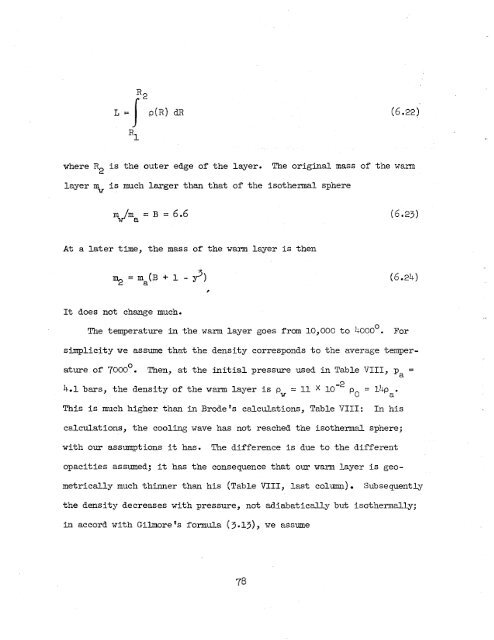Theory of the Fireball
Theory of the Fireball
Theory of the Fireball
Create successful ePaper yourself
Turn your PDF publications into a flip-book with our unique Google optimized e-Paper software.
where Re is <strong>the</strong> outer edge <strong>of</strong> <strong>the</strong> layer. The original mass <strong>of</strong> <strong>the</strong> warm<br />
layer m is much larger than that <strong>of</strong> <strong>the</strong> iso<strong>the</strong>rmal spnere<br />
W<br />
At a later time, <strong>the</strong> mass <strong>of</strong> <strong>the</strong> warm layer is <strong>the</strong>n<br />
It does not change much.<br />
(6.24)<br />
Tne tepperature in t'ne warn layer goes from 10,000 to l;OOOo, For<br />
simplicity we assume that <strong>the</strong> density corresponds to <strong>the</strong> average temper-<br />
ature <strong>of</strong> 7O0Oo. Then, at <strong>the</strong> initial pressure used in Table VI11 Y Pa -<br />
4.1 bars, <strong>the</strong> density <strong>of</strong> <strong>the</strong> warm layer is p = 11 X<br />
W Po = 14Pa.<br />
This is much higher t'nan in Brode's calculations, Table VIII: In his<br />
calculations, <strong>the</strong> cooling wave has not reached tne iso<strong>the</strong>rmal sphere;<br />
with our assumptions it has, The difference is due to <strong>the</strong> different<br />
opacities assumed; it has <strong>the</strong> consequence that our warm layer is geo-<br />
metrically much thinner than his (Table VIII, last column) Subsequently<br />
<strong>the</strong> density decreases with pressure, not adiabatically but iso<strong>the</strong>rmally;<br />
in accord with Gilmore *s fornula (3.131, we assume
















